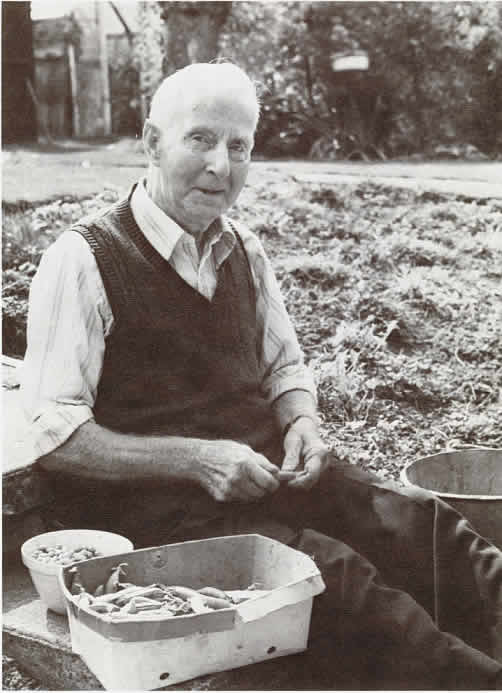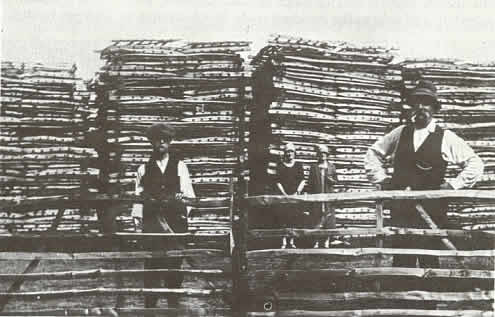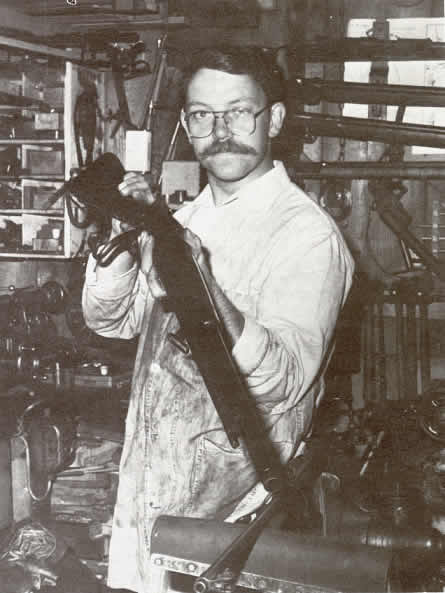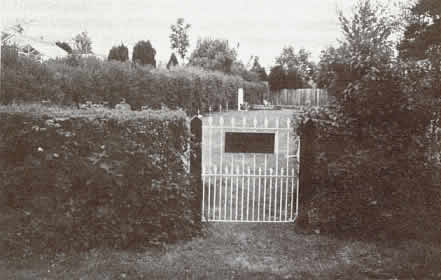Pakenham History : Pakenham-Village of Two Mills - NR Whitwell
A book written by N.R. Whitwell
with permission kindly given by S. Whitwell to publish on
the Pakenham -Village web site.
| Front Cover | Contents | Acknowledgements | Foreword | Introduction | |||||||
| C1 | C2 | C3 | C4 | C5 | C6 | C7 | C8 | C9 | C10 | C11 | C12 |
| App I | App II | App III | Epilogue | ||||||||
In the introduction, the name Peck was suggested as a likely derivation of the name Pacca, and Pacca's Ham being the home of the Pakes or Pecks. Although the families of Pecks are spread throughout the village, the family names of Peck and Tipple are synonymous with the Fen road and Grimstone End and their trade was that of chalk manufactures, lime burners and hurdlemakers.
Mr. Harry Tipple employed some 4-5 men at his whiting works which were situated along the Fen road, just beyond Bull Corner where, behind the barn, evidence still remains of the large pit from which he extracted his chalk. There is also the well pump, from which the water was drawn and used in the mixing and moulding of the chalk into balls. These were partly dried by a furnace before being placed on slats for the final drying off necessary before transporting for sale.

Charlie Tipple, Hurdle maker
The biggest demand for these balls of whitening came in the spring of each year when the cottages received their annual cleaning coat on the exterior and the ceilings in the interior. They were used on livestock stalls and boxes and for many other varied uses, including marking out the sports fields.
Mr. Tipple delivered small lots with his horse drawn lorry, but later he acquired a motor lorry for deliveries further afield. In the meantime Mr. Geo. Mole delivered 3-4 days a week to the Wattisfield, Stowmarket and Eye districts and Messrs. Ridley's of Bury St. Edmunds collected 4 tons at a time with their own vehicle, such was the trade. These "balls", as they were called, were really elongated rolls and sold for a penny ha'penny each and the whole system welded itself into a thriving business. Together with farm lands in the vicinity, men and women secured a living for themselves until the outbreak of war in 1939. Mrs. Hilda Philips (nee Tipple) still resides at The Whitings on the Fen road, exactly where the old works used to be.
Originally this whiting business belonged to a Mr. Weston, who sold it to Mr. Barbrooke, a builder in Bury St. Edmunds. He carried on for about nine years, until Mr. Harry Tipple bought it and came to live on the site in 1930. Mr. Weston also had a chalk pit and carried on a business from a general shop at Little Dean, Grimstone End, until about 1914. Might one detect a little jealousy or competition in this part of the Parish in these years?
Just over Bailey Pool Bridge at Grimstone End was another small chalk industry, but this differed from the whiting works insofar as the chalk was burnt and sold to agriculture and the building trade. The reject flints were sold to farmers who used them for sack bottoms.
This chalk pit was in the ownership of the Stowlangtoft Estate but let as a going concern. Charles Peck took over in 1908 and carried on lime burning until the Second World War, when his men were called up for military service and the demand for his product ceased in 1940.
James Peck, with brothers Charles and William and assisted by Bob Nunn, worked the lime burning business and they all lived at Grimstone End. When Charlie Peck took over the business in 1908, the pit on the Pakenham side of the Ixworth-Stowmarket road was exhausted, so a tunnel was built under the road to the Stowlangtoft side and is still there. A very good quality chalk was found and excavated, being transported back by horse and cart via the tunnel.
To reach the correct type of chalk the men were required to dig down about twenty feet and in the process the inferior and unsuitable material was sold for 1/6d per ton to farmers, who would use it to make up their yard bottoms and repair their roads. The flints were very large, but useful for the farmers to build their stacks of hay and corn on. When at the required depth, the chalk was excavated in the shape of a large cone some 12 feet in diameter and right in the bottom of the cone the fire would be made. This consisted of the usual straw, kindling and coal nuts and was kept burning night and day. The chalk was excavated from the 20ft. chalk wall in lumps about the size of potatoes (powder being no use for burning), water was added to create the lumps and as the heat of the fire grew in intensity the chalk would stick to the sides of the cone allowing the men to extract the burnt lime from the centre of the cone with special shovels and through special accesses. When cool it would be bagged up and sold to the building trade for plastering, at 1/6d per bushel.
At the outbreak of war, the top of the cone was covered at night with corrugated iron sheets, to prevent the glare being seen by enemy aircraft.
Midway along the Fen road was the hurdleyard, carried on by Sidney Tipple, the third generation of hurdlemakers in the Parish. He lived at Pudding Hall, just a little way off the Fen road and behind the hurdleyard. This business was in operation until the late 1950's.
Sidney Tipple died in 1954 at the age of 85, but when he retired at the age of 70 the business was still carried on by his family. Laurence his eldest son took charge, with his brothers Charles and Claude assisting and Ivan Nunn being a casual worker when season demanded; thus a thriving and popular family business flourished right up to the time of the introduction of the electric fence which brought about changes in the pattern of sheep control and fencing in about 1954.
The ash from which the hurdles were made preferred damp, loamy soil and did well on chalk, producing a tough, elastic timber suitable for rake handles, teeth and general hand tools, oars and hurdles. There was a correct time to cut the poles, not only for hurdlemaking but to allow the ash stubbs to recover and grow away again, ready for recutting in the following years on a rotational basis. After cutting, the ash stubbs would throw up a number of straight slender shoots in the following season. This method was known as coppice grown ash and there were several good plantations in the Parish, well known to the Tipple Brothers.
Charles Tipple, aged 85, is one of the oldest residents and still living at "Trelawne", his bungalow along the Fen Road. He has watched several flourishing industries and public houses disappear from Pakenham.
>
Pakenham Hurdleyard
Albert Nunn (killed by Japanese), Mes.
Chas Tipple,
Mrs. Laurie Tipple, Sidney Tipple.
50 doz. hurdles and 10 doz. piles
While they were operating, it was a nice time to enter the woods. The smell of the burning waste wood and tops, as the blue smoke curled upwards through the trees, would give their position sway and they would work to the accompaniment of the crow of the cock pheasant and the ruffling of his feathers, to the occasional dart of a hare and rabbit across the clearing. The wildlife would come to see what was going on and then accept this seasonal intrusion. With a surrounding carpet of primroses, violets, cowslips and anemones and other wild flowers, it made it a delightful rural occupation. Delightful as it may have been, the wages at the time were 5d per hour for the women (18/- per week) and for the men 7d per hour (£1.8.6d per week).
Having cut the poles, Charlie Tipple would load them onto his specially made drug and transport them back to the yard for treatment and subsequent manufacture. By the way Charlie handled his horse, it was apparent it knew its own way in and out of the woods and it was quite unnecessary to have a leading rein when going home.
When the season for cutting was over and the yard full of poles, the time would come for the making into hurdles. The poles would be cut into the required lengths, the bark removed from the two sides only and put into sets of 6 ledges, 3 cross pieces or braces and 2 heads to make a hurdle, the ends would be sharpened up and morticed into the heads, with a final nail to hold them into position. Sale price was 10/- per dozen.
There was a good demand for sheep hurdles for the local Lamb Sales, the Agricultural Shows and steeplechase courses all over the country, some going as far as Scotland and there was one shipment to France, that started its journey from Thurston station. So this rural industry, together with about 50 acres of land around Pudding Hall, provided a living for several families in that part of the Parish, up to about 1954, when the industry suddenly collapsed.
With both a watermill and a windmill in the Parish it would rightly be assumed that flour milling was a very important industry of the times. Much more is written of these mills elsewhere, but at the time that these other industries were flourishing, both were in operation.
The watermill, which milled both by water and steam power, was operated by Walter Cooper Hitchcock, who was the miller and also Chairman of the Parish Council from 1928-33.
At the windmill, flour milling was operated by wind and steam and carried on by John Bryant. He was also Chairman of the Parish Council from 1953-55.
Since the restoration of these old mills, both are back in use, albeit the watermill as a tourist attraction only, though the windmill is still in commercial use, but they both combine to make the Parish the only one in the country to have both types of working mill in operation. A splendid view is obtained from the gangway at the rear of the watermill, looking over the swans on the mill pond, along the river to the windmill, magnificently outlined on the sky line.
The main industries of the Fen area could not survive without meeting the population's consumer needs and so it fell to another Tipple named Clarence to meet this demand with a general Fen Shop selling all kinds of goods, especially tobacco. He ran it until about 1912 when Mr. Root bought it; he in turn was followed by Mr. Feveyear who kept shop until 1930. It is no a private residence, called Meadow View.
The village had its carpenter's shop and a wheelwright's business, also situated along the Fen road. Mr. Grant had a very important business repairing the farm wagons and tumbrils and doing general carpentry work. Especially important was the maintenance of the iron tyres that had to be fitted to the wheels. This was very fascinating and skilled work and although the site is now a coal merchant's yard, the name of Wheelwrights still remains.
The Butcher's business, complete with slaughterhouse, was run from premises at the corner of Bull road by Mr. Outlaw. He employed 4 men regularly and was able to farm about 50 acres of land on the road to the Bunbury Arms, on the right hand side. The Bull corner premises have now become a private residence.
Richard Ashley is a gunsmith operating from a workshop behind his home along Fen Road. Whenever "Champion", Richard's donkey, feels like company, she pops her head through the specially made hole connecting her quarters with the workshop.

Richard Ashley, Armourer and Gunsmith.
Picture E.A.D.T. (19 NOV 1987) & B.F.P.
(26 AUG 1983)
Richard came from Yorkshire and has been in Pakenham about fifteen years making historical replicas, also repairing antique guns for museums and carrying out more modern repair work for the Police and on military weapons - he is the armourer for the 6th Battalion, Royal Anglia Regiment. Ashley lectures on historical weapons and gives talks on firearms to the Police, the military and youth organisations.
The Fen road would not be complete without its own public house, this was The Royal Oak, kept by Mr. Frost, who also farmed the land behind the pub and which no doubt supplemented his living. This, The Woolpack, The Telegraph and The Bell, have all closed and all that remains to identify the Royal Oak is the Greene King tablet on the gable end facing the road.
These small rural industries and trades employed several people who were able to adapt to farming small acreages, not only to supplement their livelihood, but sadly through war, economic necessity, advanced technology and other reasons, their businesses have ceased to exist, with their land being absorbed into the larger farms.
Before leaving Grimstone End I think it is well to record the narrow strip of land that seems to be wedged between delightful gardens and which contains the remains of those very local inhabitants that worshipped in the old Primitive Methodist Chapel that once stood between the newly constructed bungalow now named Mill-Rise and the old cottage named Benricks which was sold for £80 some years ago!
This strip of land, measuring about 37 yards long by only 5 yards wide, is carefully maintained by James Peck, who lives further along the same road, on behalf of the Methodist Circuit in Bury St. Edmunds who hold the deeds and records of the seventeen interred in this little Methodist Cemetery.
The original Chapel was known as Ebenezer Chapel and was built in 1846 and although the present day boundary fence forms a straight line alongside Mill-Rise bungalow, the original line deviated into the garage way of the bungalow necessitating an open space with brick walling around a certain burial plot over which now stands a grassed area and a tree.
As said earlier, Pakenham, as indeed is Grimstone End, is synonymous with the family name of Peck. It comes as no surprise that a number of Pecks and their relatives are buried in this narrow strip. Besides the headstones of Victor Peck, The Oxborrow family, Brian Reeve and Charles and Sarah Peck, there are nine little white iron crosses where burial is recorded are are the future burial places for further relatives in the years to come, for the line of Pecks in Grimstone End is assured by the birth, 2 years ago, of Matthew the son of Keith, son of James, whose father and mother were united in 1974 when Sarah, aged 90, was laid to rest alongside Charles, who had predeceased her in 1951.
Walkers will have time to see over the little white gate that has a name plate, Methodist Cemetery firmly affixed, but other passers-by will not notice the narrow strip carefully maintained and neatly enclosed by the close boarded fence that surrounds it.

Methodist Cemetery Gate
For this is indeed a little piece of rural England. It is understandable that such a quiet and unspoilt part of the Parish wishes to remain so. There was considerable concern and disquiet over the proposal to construct a massive barrier across the adjoining meadows in order to carry modern traffic away from the neighbouring village of Ixworth. Although the population of the area is very small, they united in preparing a petition against such proposals and lodged their objections at the public enquiry that followed early in 1984.
At a recent Parish meeting held in the village, they turned up to make it known that the efforts of the Parish Council to provide them with street lighting, to enable them to go more safely about their business on the dark winter nights and to brighten up the narrow enclosed roadway around the "S" bends, was not appreciated at all. They made it clear that they did not want to be suburbanised, neither did they want any further development - but wished to remain as they are.
They are content for the tourists to visit the nearby watermill, for people to camp in the meadows and to fish the river, enjoy the pleasant walk up to the windmill and along the fen roadway but modern highways, street lighting, further development - No!
From the time the Iceni tribe was put down by the Romans who commanded the area from their fort at the end of the road, peace has prevailed, the Roman garrison was withdrawn at the end of the first century A.D. and there were no more revolts, the Romans were left undisturbed and they wish to be undisturbed themselves. So peace reigns supreme in this part of rural Suffolk at Grimstone End in the parish of Pakenham.





